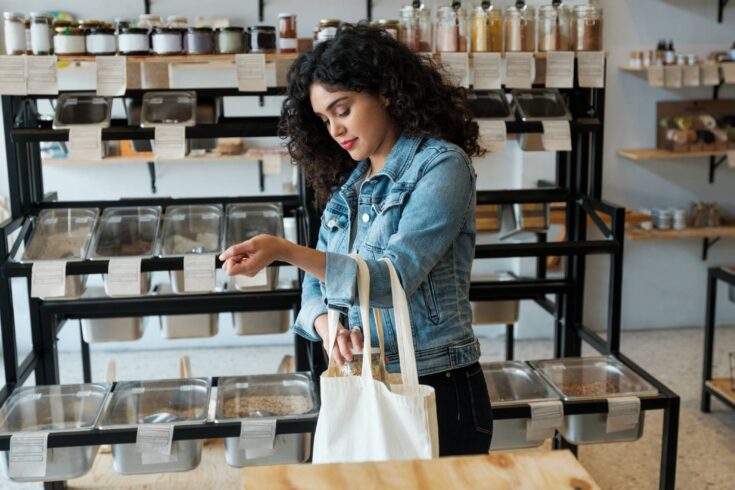My kids wore disposable nappies and my shopping habits must have used up a tsunami of plastic bags over the years. Joining The Sustainable Innovation Fund (SIF) team last year was the final (single-use plastic) straw. It was time to do something about my impact on the planet.
So, I’m now using a solid shampoo bar that comes in a cardboard wrapper. I carry a refillable water bottle. I pump cleaning products into re-usable bottles in a patchouli-scented shop. Not really enough though, is it? In my quest to do more I sought inspiration from the business world.
Sustainable solutions
SIF has funded many projects that taken individually seem like a drop in the ocean. Recycling insoles, developing sustainable insect repellent or making leather from mushrooms or seaweed won’t save the planet on their own. Add those and all the other small changes together however, and they will help bring stability and recovery to our planet.

Vegan leather handbag. Credit: Uncommon Alchemy
Small to medium-sized enterprises (SMEs) around the country are doing their bit. The Business Climate Hub is a nationwide community committed to making a big difference with small changes. With government support they are pledging to halve their carbon emissions by 2030 and to reach net zero by 2050.
Big companies such as McDonald’s are making changes too. Currently under construction is the first McDonald’s restaurant to be built to UK industry net zero emissions standards. A plant-based burger now features on the menu too.
Indeed, a quick trawl of the web showed that avoiding meat and dairy products is the single biggest way to reduce my environmental impact on the planet. Beef results in up to 105kg of greenhouse gases per 100g of protein, while tofu produces less than 3.5kg. Maybe it was time to bite the plant-based bullet.
Veggie alternatives
I have always viewed a meat-free diet through the eyes of twenty-something Veggie-Me (I saw the film Babe and experienced an epiphany of biblical proportions.) An ex-boyfriend’s mother once served me her idea of vegetarian cuisine: cannelloni tubes stuffed with dry veggie mince on a bed of mashed potato sans butter or cream. It was a meal of such epicly dry, tasteless beige-ness that I finished with him that night for fear of what might come next.
In my thirties I was lured back to the dark side by the smell of frying bacon. Nowadays I love a nice juicy steak. And seafood, and chicken, and duck… oh I’m doing Homer Simpson-esque drooling now. And in the wise words of Wallace: “Cheeeese!”: hard, soft, blue, as stinky as possible, I love it.
No. I can’t go vegan, I won’t, and you can’t make me! But before I chain myself to the meat counter, is there a middle ground? Well, yes. If we all reduced the amount of meat, we consume it would make a big difference to our carbon footprint. And honestly, it’s not as torturous as I thought.
SIF funded a plant-based meal kit: currently delivered nationwide, it will soon be available via vending machines in gyms and offices. Grubby are championing British produce and for every box sold a meal is donated to a child living in poverty in Uganda. I put the cannelloni tubes to the back of my mind and tried them, and they are really good. I honestly did not feel I was missing out without meat: the meals are delicious.
Small steps towards change
Even if you still want a protein focus on your plate, there are alternatives. Huge advances in lab-grown meat mean that very soon the meat we eat may never have moo-ed, baa-ed or clucked. In another SIF project, Born Maverick are developing sustainable Atlantic seafood alternatives made from seaweed. I pictured a nightmarish Frankenstein-prawn, fighting its way out of the frying pan, but still volunteered to try some.
I fried them with garlic butter and was pleasantly surprised: they taste and feel just like prawns and scallops. They even very nearly fooled the harshest of critics: my feline seafood connoisseur! The cost compares to real seafood, seaweed is abundant all over the world and it’s even better for the planet than trees so win-win!
So, I am now committed to having a couple of meat-free days each week. Fancy joining me? It will still taste good, and we’ll be helping the planet too. Now all we need to do is convince my cat…
Contact us
Connect with Innovate UK on LinkedIn
Follow Innovate UK on Facebook
You can go to the new Innovate UK website
You can go to the Innovate UK EDGE website
Subscribe to our YouTube channel
Sign up for our email newsletter.
Top image: Credit: aldomurillo/ Getty Images




